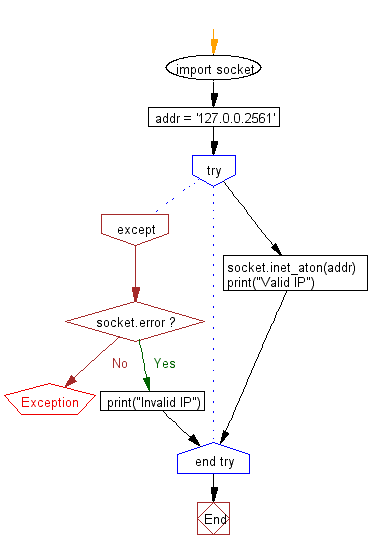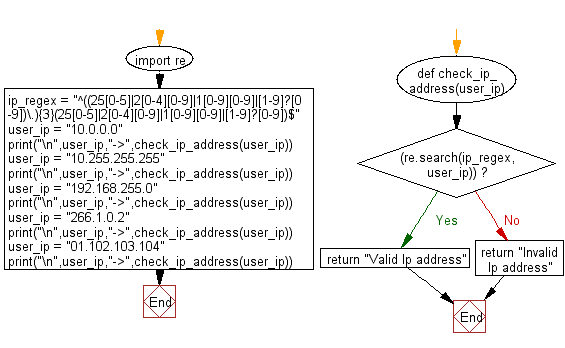Python: Valid an IP address
Python Basic: Exercise-139 with Solution
Write a Python program to valid an IP address.
From Wikipedia,
An Internet Protocol address (IP address) is a numerical label assigned to each device connected to a computer network that uses the Internet Protocol for communication. An IP address serves two main functions: host or network interface identification and location addressing.
Internet Protocol version 4 (IPv4) defines an IP address as a 32-bit number. However, because of the growth of the Internet and the depletion of available IPv4 addresses, a new version of IP (IPv6), using 128 bits for the IP address, was standardized in 1998. IPv6 deployment has been ongoing since the mid-2000s.
IP addresses are written and displayed in human-readable notations, such as 172.16.254.1 in IPv4, and 2001:db8:0:1234:0:567:8:1 in IPv6. The size of the routing prefix of the address is designated in CIDR notation by suffixing the address with the number of significant bits, e.g., 192.168.1.15/24, which is equivalent to the historically used subnet mask 255.255.255.0.
Sample Solution-1:
Python Code:
import socket
addr = '127.0.0.2561'
try:
socket.inet_aton(addr)
print("Valid IP")
except socket.error:
print("Invalid IP")
Sample Output:
Invalid IP
Flowchart:

Sample Solution-2:
Python Code:
import re
ip_regex = "^((25[0-5]|2[0-4][0-9]|1[0-9][0-9]|[1-9]?[0-9])\.){3}(25[0-5]|2[0-4][0-9]|1[0-9][0-9]|[1-9]?[0-9])$"
def check_ip_address(user_ip):
if(re.search(ip_regex, user_ip)):
return "Valid Ip address"
else:
return "Invalid Ip address"
user_ip = "10.0.0.0"
print("\n",user_ip,"->",check_ip_address(user_ip))
user_ip = "10.255.255.255"
print("\n",user_ip,"->",check_ip_address(user_ip))
user_ip = "192.168.255.0"
print("\n",user_ip,"->",check_ip_address(user_ip))
user_ip = "266.1.0.2"
print("\n",user_ip,"->",check_ip_address(user_ip))
user_ip = "01.102.103.104"
print("\n",user_ip,"->",check_ip_address(user_ip))
Sample Output:
10.0.0.0 -> Valid Ip address 10.255.255.255 -> Valid Ip address 192.168.255.0 -> Valid Ip address 266.1.0.2 -> Invalid Ip address 01.102.103.104 -> Invalid Ip address
Flowchart:

Python Code Editor:
Have another way to solve this solution? Contribute your code (and comments) through Disqus.
Previous: Write a Python program to convert true to 1 and false to 0.
Next: Write a Python program to convert an integer to binary keep leading zeros.
What is the difficulty level of this exercise?
Test your Programming skills with w3resource's quiz.
Python: Tips of the Day
Find current directory and file's directory:
To get the full path to the directory a Python file is contained in, write this in that file:
import os dir_path = os.path.dirname(os.path.realpath(__file__))
(Note that the incantation above won't work if you've already used os.chdir() to change your current working directory, since the value of the __file__ constant is relative to the current working directory and is not changed by an os.chdir() call.)
To get the current working directory use
import os cwd = os.getcwd()
Documentation references for the modules, constants and functions used above:
- The os and os.path modules.
- The __file__ constant
- os.path.realpath(path) (returns "the canonical path of the specified filename, eliminating any symbolic links encountered in the path")
- os.path.dirname(path) (returns "the directory name of pathname path")
- os.getcwd() (returns "a string representing the current working directory")
- os.chdir(path) ("change the current working directory to path")
Ref: https://bit.ly/3fy0R6m
- New Content published on w3resource:
- HTML-CSS Practical: Exercises, Practice, Solution
- Java Regular Expression: Exercises, Practice, Solution
- Scala Programming Exercises, Practice, Solution
- Python Itertools exercises
- Python Numpy exercises
- Python GeoPy Package exercises
- Python Pandas exercises
- Python nltk exercises
- Python BeautifulSoup exercises
- Form Template
- Composer - PHP Package Manager
- PHPUnit - PHP Testing
- Laravel - PHP Framework
- Angular - JavaScript Framework
- Vue - JavaScript Framework
- Jest - JavaScript Testing Framework
